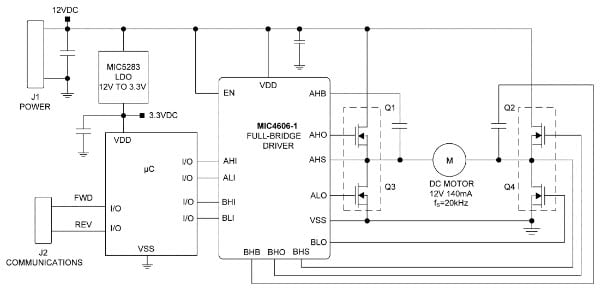
Full Bridge Mosfet Driver
Allegro MicroSystems, Inc. Announces a new full-bridge MOSFET controller for use with external N-channel power MOSFETs. The A4957 is designed for.
Allegro MicroSystems, Inc. Announces a new full-bridge MOSFET controller for use with external N-channel power MOSFETs. The A4957 is designed for applications with high-power brush DC motors.
It has a wide supply voltage range of 7 V to 50 V. This new device is targeted for commercial and industrial applications such as portable power tools, lawn and garden equipment, industrial blowers, lifts and conveyors, and forklifts.
Offered in the 24 lead ES package, Allegro's A4957 is intended to meet the performance and price point driving motors in these applications. A unique charge pump regulator provides full ( >10 V ) gate drive for supply voltages down to 7 V or as low as 4.5 V with a reduced gate drive. A bootstrap capacitor is used to provide the above battery supply voltage required for N-channel MOSFETs. A unique bootstrap charge management system ensures that the bootstrap capacitor is always sufficiently charged to supply the high-side gate drive circuit. Each of the power MOSFETs is controlled independently but all are protected from shoot-through by dead time that can be configured by the user through an external resistor. Integrated diagnostics provide indication of undervoltage and over-temperature faults. The A4957SESTR-T is supplied in a 24-lead, 4 mm × 4 mm × 0.75 mm QFN package with an exposed pad for enhanced thermal dissipation.
It is lead (Pb) free, with 100% matte tin lead-frame plating (suffix T). It is priced at $1.42 in quantities of 1,000. Part Number: A4957.
I have a full bridge MOSFET driver driver driving a full bridge. After some experimenting with the circuit prototype i found out that the driver heats up to over 60 °C after a short while of running, which concerned me but it worked fine.
However as I decreased impedance across the load (which was originally connected to primary coil of a transformer) the driver started acting in a weird way and i found out that it has blown out. This is already the second driver i destroyed this way and they're expensive as hell, so I need a solution.
I think what's causing the driver to blow out is that when I decrease impedance across the load I basically create a short circuit between the driver's bootstrap pin and ground, which kills it. By adding a resistor across the load or the whole bridge and ground, I could easily solve the issue, however I do need low impedance on the load because I need high current (up to 20A).
I thought about adding a resistor across the driver's bootstrap line, but I have concerns about it affecting the bootstrapping functionality. EDIT: I'm actually using IGBTs in place of MOSFETs (specifically IRGPS4067DPBF) Also I'm not posting a layout because the full bridge is not on a PCB but it's simply bridge-soldered to the driver circuit.
The full bridge operates at 150 kHz square wave.Both circuit and load voltage is 12v Also here's my circuit schematic: The full bridge is connected as in the driver's datasheet, except the feedback loop and shunt resistor: Here's the control circuit layout: And here's the picture of the bridge. $ begingroup $ Show us a picture, please. There was a recent case (maybe 2-3 weeks ago) of a guy blowing his bridge driver. So I told him to put decoupling caps on the power rail and that solved it. Fast switching of a high current combined with supply wire inductance to create a nasty L*di/dt spike which blew the chips.
It wasn't load inductance in this case, simply the power supply wires. The nastiness (di/dt) is proportional to the current, so I'm not surprised it works at low current then blows when current gets high.
$ endgroup $ – May 18 '17 at 16:38 •. Your layout may be sloppy.
T-Mobile HTC HD7 is world?s first phone based on Microsoft Window Phone7 and boasts of all features of young generation phone, No. 
They can also include information like your site’s latest updates, frequency of changes and the importance of URLs. Be sure to only include the pages you want search engines to crawl, so leave out any that have been blocked in a robots.txt file. Contain the list of your URLs that are available to index and allow the search engines to read your pages more intelligently. Uchebnik risunok andriyaki.
Blowing the driver out at high load current (as opposed to shoot through, which is independent of current) usually indicates that you have stray inductance which is causing excursions at the driver output that are unacceptable. Try adding some reasonable series gate resistance (15 or 20 ohms) and clean up your layout to minimize loop areas that carry load current.
Make sure you have bypass capacitors on the 80V and 12V buses. Generally 150kHz is quite a high switching frequency for IGBTs, also IGBTs are not a very good choice at low voltage- they have a lot of voltage drop. MOSFETs are typically a superior solution when voltages are low- their big advantage is that they are available and are inexpensive (small die size) with very high voltage ratings (eg.
1200V) and the voltage drop does not get worse.